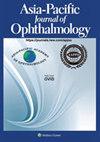儿童近视的基因。
IF 4.5
3区 医学
Q1 OPHTHALMOLOGY
引用次数: 0
摘要
近视与遗传和环境因素的相互作用有关。儿童近视的发展可能更多地依赖于遗传背景。候选基因分析、全外显子组测序、全基因组关联研究(GWAS)和随后的荟萃分析已经确定了400多个与近视相关的基因座。然而,大多数基因组研究都是在成人中进行的,只有少数在成人GWAS中发现的遗传单核苷酸多态性已成功地在儿童中复制。在这篇综述中,我们总结了这些变异,并比较了儿童和成人之间的效应量。本文章由计算机程序翻译,如有差异,请以英文原文为准。
Genes for childhood myopia
Myopia is associated with interactive effects of genetic and environmental factors. The development of myopia in childhood is likely to be more dependent on genetic background. Candidate gene analysis, whole exome sequencing, genome-wide association studies (GWAS) and subsequent metaanalyses have identified more than 400 loci that are associated with myopia. However, most genome studies have been conducted in adults and only a few of genetic single nucleotide polymorphisms identified in adult GWAS have been successfully replicated in children. In this review, we summarized these variants and compared the effect size between children and adults.
求助全文
通过发布文献求助,成功后即可免费获取论文全文。
去求助
来源期刊

Asia-Pacific Journal of Ophthalmology
OPHTHALMOLOGY-
CiteScore
8.10
自引率
18.20%
发文量
197
审稿时长
6 weeks
期刊介绍:
The Asia-Pacific Journal of Ophthalmology, a bimonthly, peer-reviewed online scientific publication, is an official publication of the Asia-Pacific Academy of Ophthalmology (APAO), a supranational organization which is committed to research, training, learning, publication and knowledge and skill transfers in ophthalmology and visual sciences. The Asia-Pacific Journal of Ophthalmology welcomes review articles on currently hot topics, original, previously unpublished manuscripts describing clinical investigations, clinical observations and clinically relevant laboratory investigations, as well as .perspectives containing personal viewpoints on topics with broad interests. Editorials are published by invitation only. Case reports are generally not considered. The Asia-Pacific Journal of Ophthalmology covers 16 subspecialties and is freely circulated among individual members of the APAO’s member societies, which amounts to a potential readership of over 50,000.
 求助内容:
求助内容: 应助结果提醒方式:
应助结果提醒方式:


